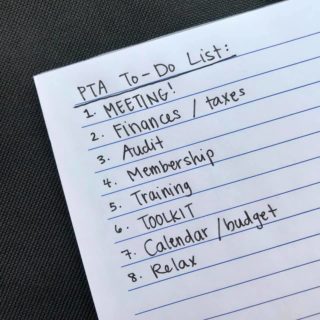January marks the time to think about the election of your PTA’s nominating committees!
Your local bylaws determine when your nominating committee should be elected, typically in January or February. The nominating committee election occurs at an association meeting at least two months before the annual election meeting. This timing is important because it:
- gives the committee one month to identify a slate of PTA officers,
- provides time for the 30-day member notice of the annual meeting, and
- provides time for the 28-day notice of the slate of nominees.
The bylaws also indicate how many members are elected to serve on the committee and how many alternates are required.
Why is the nominating committee the most important committee of the PTA?
They will identify your PTA’s future leaders. Consider the qualifications of the committee members carefully. They must understand and appreciate the school culture and its ethnicities, have knowledge of past PTA accomplishments, and understand who would best advance the work of PTA in your community. Those elected for service must observe strict confidentiality and must be individuals trusted by the community. They must have time to serve, be ready to work as a team, discuss delicate matters, and have an understanding of the roles of the officer positions. In the California State PTA Toolkit Nominations and Elections section, you’ll find additional guidance for the important task of electing the nominating committee:
https://capta.org/pta-leaders/run-your-pta/nominations-and-elections/
Two requirements, in particular, ensure an unbiased nomination process. Individuals are ineligible to serve twice (back-to-back) and the president never serves on the committee. The principal, if not elected to serve on the committee, is always a consultant and would be a voting member if serving on the committee. Committee members serve until the annual election meeting.
How does the Nominating Committee do its work?
At its first meeting, the members elect the chair with the parliamentarian’s assistance. If an elected member is unable to attend the first meeting, then an alternate member steps in for the duration of the committee’s work. During discussion, committee members select the most qualified nominees for each position. Ask your PTA’s current officers to provide a short paragraph or outline of their duties or to share their procedure books.
The committee members can interview candidates as a group or assign teams to conduct interviews. Refer to National PTA’s resources for sample questions and a candidate checklist. When there is ample time, committees may develop and distribute an application to inspire individuals’ interest in serving. Committees may also survey the PTA’s members to determine whom they believe are qualified leaders.
The nominee for president is identified first, then the positions of secretary, treasurer. The other officers follow once the three required positions have been slated. The committee is not obligated to nominate individuals for their preferred positions, nor advance an executive vice president or first vice president to the position of president. The best leaders are adaptable and essential skills apply to all roles. The committee looks for individuals committed to the PTA principles, keeping the names of candidates confidential from other potential candidates. Committee members do not bargain with candidates or waive job duties as described. Nominees for appointed officers and chairs are not included in the work of the committee. After the election, the president-elect makes appointments for these positions, which are ratified by the board-elect.
Once a slate has been agreed upon by the committee, the committee chair notifies the president of the slate, who releases the information no later than 28 days prior to the annual meeting. The committee continues its work if any positions do not have a nominee or should one withdraw. At the election meeting the chair presents the slate to the membership.
Plan now to elect your PTA’s most qualified members to this important committee. The future of your PTA depends on the essential work of the nominating committee today.
 Getting started as a brand-new PTA officer can seem daunting at first. There’s a lot that needs to be done to get things up and running, but who does what, and in what order?
Getting started as a brand-new PTA officer can seem daunting at first. There’s a lot that needs to be done to get things up and running, but who does what, and in what order?